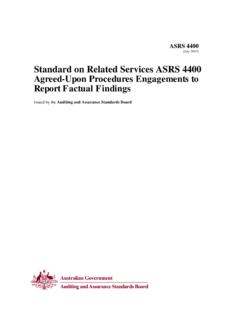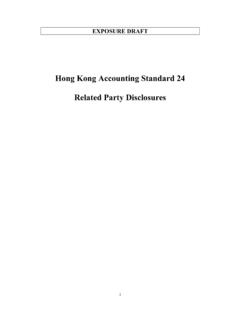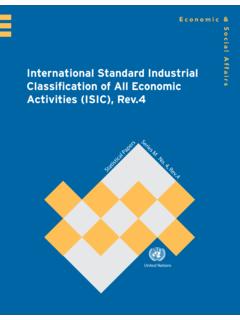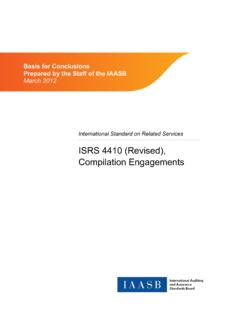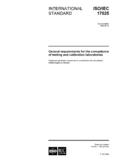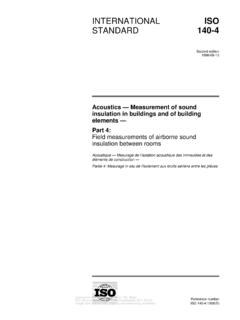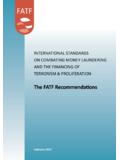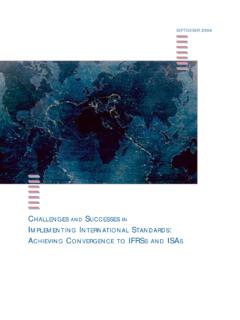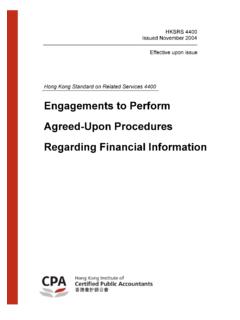Transcription of INTERNATIONAL ISO/IEC STANDARD 27001 - …
1 Reference numberISO/IEC 27001 :2005(E) ISO/IEC 2005 INTERNATIONAL STANDARD ISO/IEC27001 First edition2005-10-15 Information technology Security techniques Information security management systems Requirements Technologies de l'information Techniques de s curit Syst mes de gestion de s curit de l'information Exigences ISO/IEC 27001 :2005(E) PDF disclaimer This PDF file may contain embedded typefaces. In accordance with Adobe's licensing policy, this file may be printed or viewed but shall not be edited unless the typefaces which are embedded are licensed to and installed on the computer performing the editing. In downloading this file, parties accept therein the responsibility of not infringing Adobe's licensing policy. The ISO Central Secretariat accepts no liability in this area. Adobe is a trademark of Adobe Systems Incorporated. Details of the software products used to create this PDF file can be found in the General Info relative to the file; the PDF-creation parameters were optimized for printing.
2 Every care has been taken to ensure that the file is suitable for use by ISO member bodies. In the unlikely event that a problem relating to it is found, please inform the Central Secretariat at the address given below. ISO/IEC 2005 All rights reserved. Unless otherwise specified, no part of this publication may be reproduced or utilized in any form or by any means, electronic or mechanical, including photocopying and microfilm, without permission in writing from either ISO at the address below or ISO's member body in the country of the requester. ISO copyright office Case postale 56 CH-1211 Geneva 20 Tel. + 41 22 749 01 11 Fax + 41 22 749 09 47 E-mail Web Published in Switzerland ii ISO/IEC 2005 All rights reserved ISO/IEC 27001 :2005(E) ISO/IEC 2005 All rights reserved iiiContents Page iv 0 Introduction .. v v Process v Compatibility with other management systems.
3 Vi 1 Scope ..1 Application ..1 2 Normative references ..1 3 Terms and definitions ..2 4 Information security management system ..3 General Establishing and managing the Establish the Implement and operate the ISMS ..6 Monitor and review the Maintain and improve the Documentation Control of documents ..8 Control of 5 Management responsibility ..9 Management commitment ..9 Resource management ..9 Provision of resources ..9 Training, awareness and 6 Internal ISMS 7 Management review of the ISMS ..10 Review Review 8 ISMS Continual Corrective Preventive action ..12 Annex A (normative) Control objectives and Annex B (informative) OECD principles and this INTERNATIONAL STANDARD ..30 Annex C (informative) Correspondence between ISO 9001:2000, ISO 14001:2004 and this INTERNATIONAL Bibliography ..34 ISO/IEC 27001 :2005(E) iv ISO/IEC 2005 All rights reserved Foreword ISO (the INTERNATIONAL Organization for Standardization) and IEC (the INTERNATIONAL Electrotechnical Commission) form the specialized system for worldwide standardization.
4 National bodies that are members of ISO or IEC participate in the development of INTERNATIONAL standards through technical committees established by the respective organization to deal with particular fields of technical activity. ISO and IEC technical committees collaborate in fields of mutual interest. Other INTERNATIONAL organizations, governmental and non-governmental, in liaison with ISO and IEC, also take part in the work. In the field of information technology, ISO and IEC have established a joint technical committee, ISO/IEC JTC 1. INTERNATIONAL standards are drafted in accordance with the rules given in the ISO/IEC Directives, Part 2. The main task of the joint technical committee is to prepare INTERNATIONAL standards . Draft INTERNATIONAL standards adopted by the joint technical committee are circulated to national bodies for voting. Publication as an INTERNATIONAL STANDARD requires approval by at least 75 % of the national bodies casting a vote.
5 Attention is drawn to the possibility that some of the elements of this document may be the subject of patent rights. ISO and IEC shall not be held responsible for identifying any or all such patent rights. ISO/IEC 27001 was prepared by Joint Technical Committee ISO/IEC JTC 1, Information technology, Subcommittee SC 27, IT Security techniques. ISO/IEC 27001 :2005(E) ISO/IEC 2005 All rights reserved v0 Introduction General This INTERNATIONAL STANDARD has been prepared to provide a model for establishing, implementing, operating, monitoring, reviewing, maintaining and improving an Information Security Management System (ISMS). The adoption of an ISMS should be a strategic decision for an organization. The design and implementation of an organization s ISMS is influenced by their needs and objectives, security requirements, the processes employed and the size and structure of the organization.
6 These and their supporting systems are expected to change over time. It is expected that an ISMS implementation will be scaled in accordance with the needs of the organization, a simple situation requires a simple ISMS solution. This INTERNATIONAL STANDARD can be used in order to assess conformance by interested internal and external parties. Process approach This INTERNATIONAL STANDARD adopts a process approach for establishing, implementing, operating, monitoring, reviewing, maintaining and improving an organization's ISMS. An organization needs to identify and manage many activities in order to function effectively. Any activity using resources and managed in order to enable the transformation of inputs into outputs can be considered to be a process. Often the output from one process directly forms the input to the next process. The application of a system of processes within an organization, together with the identification and interactions of these processes, and their management, can be referred to as a process approach.
7 The process approach for information security management presented in this INTERNATIONAL STANDARD encourages its users to emphasize the importance of: a) understanding an organization s information security requirements and the need to establish policy and objectives for information security; b) implementing and operating controls to manage an organization's information security risks in the context of the organization s overall business risks; c) monitoring and reviewing the performance and effectiveness of the ISMS; and d) continual improvement based on objective measurement. This INTERNATIONAL STANDARD adopts the "Plan-Do-Check-Act" (PDCA) model, which is applied to structure all ISMS processes. Figure 1 illustrates how an ISMS takes as input the information security requirements and expectations of the interested parties and through the necessary actions and processes produces information security outcomes that meets those requirements and expectations.
8 Figure 1 also illustrates the links in the processes presented in Clauses 4, 5, 6, 7 and 8. The adoption of the PDCA model will also reflect the principles as set out in the OECD Guidelines (2002)1) governing the security of information systems and networks. This INTERNATIONAL STANDARD provides a robust model for implementing the principles in those guidelines governing risk assessment, security design and implementation, security management and reassessment. 1) OECD Guidelines for the Security of Information Systems and Networks Towards a Culture of Security. Paris: OECD, July 2002. ISO/IEC 27001 :2005(E) vi ISO/IEC 2005 All rights reserved EXAMPLE 1 A requirement might be that breaches of information security will not cause serious financial damage to an organization and/or cause embarrassment to the organization.
9 EXAMPLE 2 An expectation might be that if a serious incident occurs perhaps hacking of an organization s eBusiness web site there should be people with sufficient training in appropriate procedures to minimize the impact. InterestedParties Managed information securityInformation security requirements and expectationsInterestedParties PlanDoCheckActMonitor andreview the ISMSM onitor andreview the ISMSI mplement andoperate the ISMSI mplement andoperate the ISMSM aintain andimprove the ISMSM aintain andimprove the ISMSE stablishISMSE stablishISMSI nterestedParties Managed information securityInformation security requirements and expectationsInterestedParties PlanDoCheckActMonitor andreview the ISMSM onitor andreview the ISMSI mplement andoperate the ISMSI mplement andoperate the ISMSM aintain andimprove the ISMSM aintain andimprove the ISMSE stablishISMSE stablishISMS Figure 1 PDCA model applied to ISMS processes Plan (establish the ISMS)
10 Establish ISMS policy, objectives, processes and procedures relevant to managing risk and improving information security to deliver results in accordance with an organization s overall policies and objectives. Do (implement and operate the ISMS) Implement and operate the ISMS policy, controls, processes and procedures. Check (monitor and review the ISMS) Assess and, where applicable, measure process performance against ISMS policy, objectives and practical experience and report the results to management for review. Act (maintain and improve the ISMS) Take corrective and preventive actions, based on the results of the internal ISMS audit and management review or other relevant information, to achieve continual improvement of the ISMS. Compatibility with other management systems This INTERNATIONAL STANDARD is aligned with ISO 9001:2000 and ISO 14001:2004 in order to support consistent and integrated implementation and operation with related management standards .

